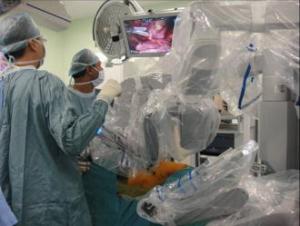Oct 26 2010
Surgeons at the National Heart Centre Singapore (NHCS) have performed robotic Lobectomy, the latest robot-assisted and precise method of treating early stage lung cancer. It was reported that two robotic Lobectomies have been performed at NHCS since August and both have resulted in positive outcomes.
In robotic Lobectomy, four small holes each measuring 1cm to 4 cm are made on the body and with the help of robotic arms the probes are inserted into the body for removing the tumor mass. Handles on a remote console enable the surgeons to control the robotic arms.
 Robot-Assisted Lobectomy
Robot-Assisted Lobectomy
The previous method of treating lung cancer is by video-assisted thoracoscopic surgery (VATS), which involves the insertion of probes manually, resulting in decreased manoeuvrability of the probe with respect to the movement of the human hand. But the robotic arms can offer intricate tremble-free movement superior to the human hand motion. Also in VATS the camera has to be introduced into the body for broadcasting the lung image to a computer screen. Since the resulting image is two dimensional, field depth measurement is highly tedious, but the robotic technology offers a three dimensional image of the chest cavity with the help of the remote console.
Dr Su Jang Wen, Consultant, Department of Cardiothoracic Surgery in NHCS, who is the only trained Lobectomy surgeon at NHCS, has stated that the accuracy of the robot-assisted surgery has offered enhanced patient safety. He added that since the probe is not handled by the surgeon he will not realize the amount of pressure employed while making incisions which is a major drawback of this method. It was reported that in another five years NHCS will train around three surgeons to perform this surgery.
Only early-stage lung cancer patients can be treated with this technique since it involves very small incisions allowing the elimination of minor tumors. But later-stage lung cancer involves bulky tumors requiring a long incision measuring 10 and 15 cm.
At present, robotic Lobectomy has been performed globally in 25 medical centers and so far around 3000 procedures have been completed.